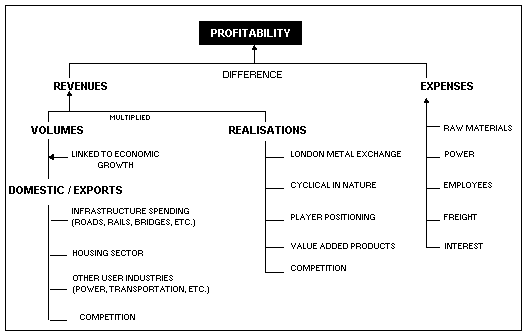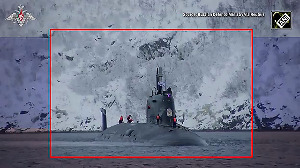Investing in commodity stocks is always a risky proposition because the cyclicality of the sector is one of the most important criteria, which decides the fate of your investments.
Keeping this in mind, we have tried to highlight here some factors one should keep in mind before investing in an aluminium company.

Profile
The biggest trait of the aluminium industry, being a commodity, is the cyclicality of the industry, wherein there are periodic ups and downs. That said, when compared with cement and steel, aluminium is a value-add commodity.
It is a highly capital intensive sector (Rs 200 bn required for a 1 million tonne greenfield capacity expansion). Cost efficiency plays a critical role in the survival of a company in the sector for which, control over inputs (say raw material) is of utmost importance.
Fortunately, the advantage of having the 5th largest bauxite reserves in the world coupled with cheap and abundant labour helps the Indian companies to retain the distinction of being the lowest cost producers in the world.
Globally, the industry is less fragmented when compared with steel and cement.
On basis of scale of operations and level of integration, aluminium producers can be categorized into the following two types:
Integrated producers/Primary producers: Integrated producers have presence right from the mining of bauxite (raw material) to producing aluminium ingots (finished product). Some companies may even go a step further and have downstream manufacturing facilities such as manufacturing of semi-fabricated products (foils). Primary producers could either be a company that is just into mining of bauxite and alumina production or pure aluminium ingot manufacturing. For companies, which have restricted themselves from venturing into the downstream segment, the user industries are basically the secondary producers.
Secondary producers: For this segment of producers, which are involved in the production of semi-fabricated products, the raw material is acquired from primary producers, which is in the form of aluminium ingots and billets. The user industries for this segment would be the packaging industry (foils), auto ancillary (wheels), to name a few.
Aluminium products can be classified under three categories. Rolled products find applications in automobiles, consumer durable, construction and engineering sectors. Extrusions include bars, pipes and tubes that find usage in the electrical and the transportation sectors. Finally, foils are used in the packaging sector, which are high-value products and have higher margins.
Now let us proceed with the various parameters indicated in the flowchart above:
Revenues
Revenues = Volumes * Realisations
Let's look at the volumes side first.
Volumes
Growth prospects of the aluminium industry are a function of economic growth. In the Indian context, economic slowdown does influence the demand for aluminium, as its user industries like infrastructure, transportation, consumer durables and housing get affected.
It must be noted that the consumption pattern of aluminium in India is tilted largely in favour of power and electricity (over 1/3rd of total consumption), as against the world consumption pattern, wherein transportation, especially airlines, have a major role to play.
Whenever there is an economic slowdown, demand is affected in these sectors that in turn impact aluminium sales.
The key application of aluminium across sectors is in products like power transformers, railways, auto industry (components and body building), housing (furnishing), packaging (competition is from tin and plastic) and consumer durable sector (body parts).
Investors could gauge potential for aluminium demand based on the aforesaid user industries.
Other user industries
The industry is also looking at increasing volume sales by presenting itself to the steel-user industries as a good substitute option on the basis of its qualities of strength and lesser weight.
This could be a potential opportunity for aluminum, as user industries like auto, could switch to aluminium. Globally, this is a growing trend in the developed economies.
Competition
On the domestic front, protection from competition is in the form of tariffs, which makes the landed cost of aluminium into the country comparatively expensive vis-à-vis the domestic produce. Investors have to keep in mind that when customs duty falls, threat of imports increases unless domestic producers are competitive.
Realisations
Some factors, which determine the realisations for the company, are:
-
London Metal Exchange (LME): Unlike steel and cement, pricing for aluminium is determined at a global exchange called LME. This serves as a benchmark. Prices are determined depending upon the demand-supply mismatch, which in turn is dependent on the economic cycle.
When aluminium prices start firming, in order to cash in on the rise in price, manufactures increase the capacity utilisation, which ultimately distorts the demand-supply picture and prices start to weaken. If demand fails to match production, the consequent rise in inventory impacts prices and vice-versa.
Domestic prices closely track international price movements. However, the volatility on the domestic front is reduced to a certain extent owing to factors like import tariff protection and the absence of fragmentation in the domestic aluminium industry (Two players control 70% of the domestic market).
-
Player positioning: This factor plays a crucial role in determining the profitability of a company. Since a company can be largely present in the upstream segment or the downstream segment or be an integrated player, the cyclicality of the industry has a varying effect on the performance of the company.
For example, a company, which is largely present in the upstream segment, will be prone to volatility. This is because raw material prices increase or decrease depending upon aluminium production. Whereas, a company, which has a significant presence in the downstream segment, margins will be squeezed in a cyclical upturn, as aluminium prices strengthen. The ability to pass on the rise in input costs is relatively less.
However, an integrated player is best placed as he has the advantage of captive mining, which will protect its input costs, while its presence in the downstream segment will help it to keep a check on the realisation aspect.
-
Value added products: Realisations are also dependant to a large extent on the product profile of the company. Companies with a larger presence in value added segments (downstream segment) like extrusions, foils and aluminium wheels are able to realise higher value for their products, which assists margin improvement.
-
Competition: Competition is more global in nature for the sector, similar to other sectors. However, since Indian companies are among the lowest cost producers in the world, pressure of imports is negated to that extent.
Indian companies are also protected in the domestic markets from international competition, owing to tariffs imposed on aluminium imports. However, with the government committed to bringing down the tariff levels, companies will have to improve cost efficiencies to protect margins.
Expenses
As pointed above, in the face of increasing competition, survival would depend on cost efficiency, more so given the commodity nature of the business. Some of the key expense heads pertain to raw material, power, employees and interest cost.
Since raw material and power constitute over 50% of the total operating expenses, companies with captive facilities have an added advantage. Employee expense is the next big contributor with a share of 12%-15% of the total operating expenses.
If the company has presence in mining, employee requirements tend to be on the higher side. Freight is another important cost, which is dependent on the company's proximity to the raw material source and also to customers.
Finally, as aluminium companies are capital-intensive in nature and have significant exposure to debt, managing interest cost is of utmost importance.
Key parameters to be kept in mind while investing in an aluminium company:
-
Cyclicality of the sector: As mentioned above, the industry is cyclical in nature. Nevertheless, identifying the bottom of the cycle is not an easy task. Instead to trying to time the cycle, investors could take a view based on growth prospects of user industries mentioned in this article.
Globally, the performance of the airline industry plays a vital role as well. While this is not true on all occasions, capacity expansion could also be a good indicator.
-
Integration advantage: Whether the company is integrated aluminium producer or not is a key factor for consideration. More so, as backward integration has various advantages such as control over mines (raw material) and also captive power facilities that help keep a check on cost efficiency of the company.
-
Operating performance: Margins tend to improve at a faster pace when cycle is on the path to recovery and vice versa. However, players with larger presence into contract sales and value added products are relatively insulated from the aluminium cycle.
In this regard, operating profit margins (OPM) is one parameter to consider. OPM is also dependant on various internal parameters such as raw material consumption and power cost per unit and production per employee. All these information are available in the balance sheet for retail investors.
However, it must be noted that in the case of production per employee, the numbers could be skewed to the extent of the companies' presence into mining of raw materials.
-
Valuations: Two important ratios to look at before investing in an aluminium company could be the Price to Earnings (P/E) ratio and the Price to Book Value (P/BV). Since the industry's performance is linked to economic growth, the P/E multiple of the stock should more or less hover around the country's GDP growth.
However, at the same time, companies with greater exposure to international markets (exports) and/or larger presence in the downstream segment could command a higher valuation. The P/BV ratio can also be used as a parameter for comparison.
To sum it up, large integrated companies with significant economies of scale and high cost efficiencies with presence in international markets and valued added products are the best positioned to capitalize on any increase in demand for the metal.
This is part of Equitymaster's Reflections 2004 series. Equitymaster.com is one of India's premier finance portals. The web site offers a user-friendly portfolio tracker, a weekly buy/sell recommendation service and research reports on India's top companies.







 © 2025
© 2025